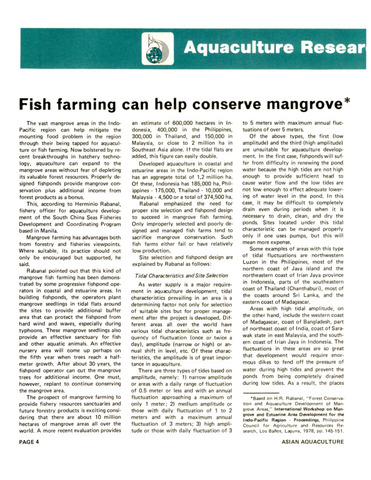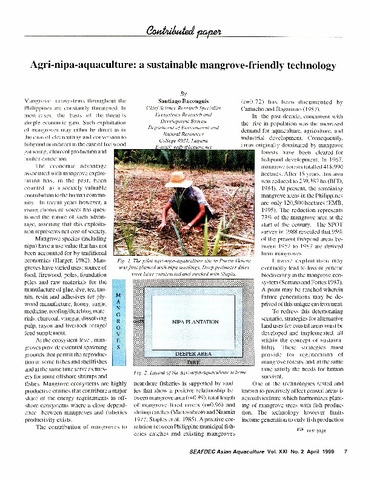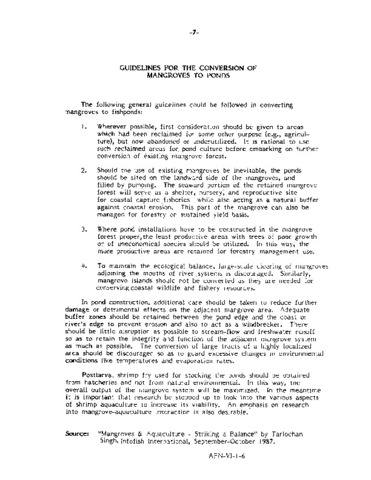| dc.contributor.author | Abrogueña, Jeff Bogart R. | |
| dc.contributor.author | Bagarinao, Teodora | |
| dc.contributor.author | Chícharo, Luís | |
| dc.date.accessioned | 2015-04-09T11:34:19Z | |
| dc.date.available | 2015-04-09T11:34:19Z | |
| dc.date.issued | 2012 | |
| dc.identifier.citation | Abrogueña, J. B. R., Bagarinao, T. U., & Chícharo, L. (2012). Fish habitats in a small, human-impacted Sibunag mangrove creek (Guimaras, Philippines): a basis for mangrove resource enhancement. Ecohydrology & Hydrobiology, 12(4), 311–319. | en |
| dc.identifier.issn | 1642-3593 | |
| dc.identifier.uri | http://hdl.handle.net/10862/2171 | |
| dc.description.abstract | The fish assemblage of a small, open access mangrove creek highly influenced by aquaculture farms, was studied for the first time in the Philippines as a baseline of such system as well as examining the degree of ecological disturbance among fish habitats, as basis for the necessity to rehabilitate mangrove resources aiming to balance human activities and mangrove functioning. In total, 475 fishes (total weight = 3875 g) were captured and 50 species representing 32 families were identified. Thirty two species were represented by small numbers (< 5 individuals). Commercial species was considerably high (~23 species) but majority were low grade commercial species. Total species, species diversity and fish abundance consistently showed a decreasing pattern from outside creek to inner creek. Fish habitats exhibited substantial differences following a distinct spatial segregation of fish communities, a dominance of non-shared species and a minimal species overlapping inside the creek, which is attributable to the existing mangrove fragmentation associated with aquaculture ponds in the area. Increasing levels of disturbances were observed within the creek indicating ‘stress’ as a result of overutilization of mangroves by aquaculture farms. Our results confirmed the need to rehabilitate mangrove resources in this area. The development of mangrove resources through reforestation, coupled by strict regulation of fishing activities and aquaculture ponds will reduce ecological stress in the area and regain gradually a robust mangrove functioning that will improve fish diversity, fisheries and productivity of adjacent coastal systems by creating a suitable fish nursery, feeding ground and refuge habitat. | en |
| dc.description.sponsorship | J.B.R. Abrogueña is grateful for the thesis grant given by the Erasmus Mundus Master of Science in Marine Biodiversity and Conservation (EMBC). | en |
| dc.language.iso | en | en |
| dc.publisher | Elsevier | en |
| dc.subject | Fish assemblage | en |
| dc.subject | Small mangrove creek | en |
| dc.subject | disturbance | en |
| dc.subject | Aquaculture pond | en |
| dc.subject | Fragmented mangroves | en |
| dc.subject | farms | en |
| dc.subject | reforestation | en |
| dc.subject | Philippines | en |
| dc.title | Fish habitats in a small, human-impacted Sibunag mangrove creek (Guimaras, Philippines): a basis for mangrove resource enhancement | en |
| dc.type | Article | en |
| dc.citation.volume | 12 | |
| dc.citation.issue | 4 | |
| dc.citation.spage | 311 | |
| dc.citation.epage | 319 | |
| dc.citation.journalTitle | Ecohydrology & Hydrobiology | en |
| dc.subject.asfa | habitats | en |
| dc.subject.asfa | fisheries | en |
| dc.subject.asfa | animal population | en |
| dc.subject.asfa | aquaculture | en |
| dc.subject.asfa | rivers | en |
| dc.subject.asfa | mangrove swamps | en |
| dc.subject.asfa | feeding | en |
| dc.subject.asfa | abundance | en |
| dc.subject.asfa | ponds | en |
| dc.subject.asfa | fishing | en |
| dc.subject.asfa | species diversity | en |
| dc.subject.asfa | commercial species | en |
| dc.subject.asfa | mangroves | en |
| dc.subject.asfa | biomass | en |
| dc.identifier.doi | 10.2478/v10104-012-0025-z | |



